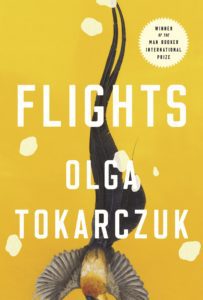
Olga Tokarczuk’s Flights, translated by Jennifer Croft, is a constellation novel of over one hundred story fragments, some narrated by a nameless woman who wanders the globe, others appearing out of a contextless ether. As a child, the sometimes-narrator “realize[s] that—in spite of all the risks involved—a thing in motion will always be nobler than a thing in permanence.” This belief guides the entire novel: loyalty to motion over the static, to travel—through time, the world, the body.
Obsessions and desires guide the travel impulse, and their pull moves the body through the world. Tracking the obsessions and desires of a multitude of beings, the novel hopscotches through time. “Constellation, not sequencing, carries truth,” announces one character, a travel psychologist. And so, rather than a linear, or even circular, time, the novel’s fragmentary structure models a vision of time as a vast archipelago, or a multi-layered pattern we have yet to uncover.
Through this unorthodox structure, Flights gives a form to motion. A book fixes things in place and time by its physical nature—words upon a page, pages stitched together, bound between covers. But a good work, a novel of real power, remains changeable. A book like that, like Flights, is something new every time you come to it. It shifts its face, opens up an altered way of seeing, keeps your thoughts in motion.
Besides movement, the narrator is drawn
to all things spoiled, flawed, defective, broken… interested in whatever shape this may take, mistakes in the making of the thing, dead ends… [her] weakness is for tetratology and freaks.
Preserved bones, skulls with growths, fetuses; hearts, stomachs, kidneys; made of wax, stuffed and coated in varnish, preserved in fluid: she trails them all over the world, into museums and basements and cabinets of curiosities.
Curious, too, are the people who move through the novel. A biologist returns to the Poland she fled decades ago, in order to euthanize her college sweetheart. A classicist’s wife contemplates mythology and mortality. Travel psychologists lecture voyagers in airport waiting halls. An anatomist’s daughter/assistant considers becoming a sailor on the high seas. A woman writes increasingly raging letters to the eighteenth-century emperor who has had her father’s body stuffed and displayed. A doctor interested only in anatomy and vaginas tries to pry a dead man’s secrets from his living wife. And on and on.
The anatomists that appear in the book, people who preserve bodies and body parts, inhabit conflicting impulses. Halting the flow of blood and time in the body, they take once-living tissues and preserve them in solutions or with varnish, trying to keep them as they are for as long as possible. But in doing so, these anatomists turn pieces of the body into travelers: through space, in collections that sail across oceans and end up in other lands, and in time, as the specimens outlive the bodies that housed them and the people that preserved them. They become fixed points, sites of pilgrimage for others with the same obsessions.
Trying to write about the magnetism and oddity of this book, I feel like the character Kunicki, a Polish man whose family disappears while on vacation, then reappears inexplicably. At first a man “capable of thinking about nothing,” Kunicki becomes obsessed with details and unravelling, plotting everything on a linear, chronological plane. In his wife’s absence, Kunicki photographs her belongings, trying to find a different way of seeing, of extracting meaning from objects—or of creating it. Upon her return, he finds himself unable to stop questioning her, to stop grasping for an understandable and palatable reconstruction of her absence.
It’s not unlike the project of the book itself—a constellation of stories, pronouncements, re-imagined histories, observations—but while the novel ends up being more than the sum of its parts, Kunicki makes things even less than their pieces, cracks his life apart at the seams, keeps insisting on straightening something un-definable. His obsession spirals into insanity.
The character Philip Verheyen’s obsession also drives him to madness. Anatomist and illustrator, discoverer of the Achilles tendon through the dissection of his own amputated leg, he is plagued by phantom pains which lead him to isolation, insanity, and death. On this journey, he composes letters to his limb:
“Why am I in pain?” he writes. “I’ve spent my life traveling, into my own body, into my own amputated limb. I’ve prepared the most accurate maps… I believe I have not missed even the smallest part. Today I can ask myself this question: What have I been looking for?”
What had he been looking for? Answers to the pains that plagued him were not forthcoming in his lifetime or his century. Verheyen was concerned with the soul and the body, with how they coincided, with wholeness. He carved into his own limb to try and understand. What he was looking for is kin to what everyone in this novel, on their various travels, has looked for. Each of them dissatisfied, aching for something more, and unable to name it.
The characters move through cities, memories, country-sides, skies, thoughts, oceans, times, and their own bodies. The alternative is stagnation. “Life… consists in bursting open, thrusting forward, in constantly going beyond what it is,” muses one character, a biologist. And so, rather than ending, the book thrusts forward, closing on a scene of someone’s travels beginning. The words act as a push, like a wind at your back.




